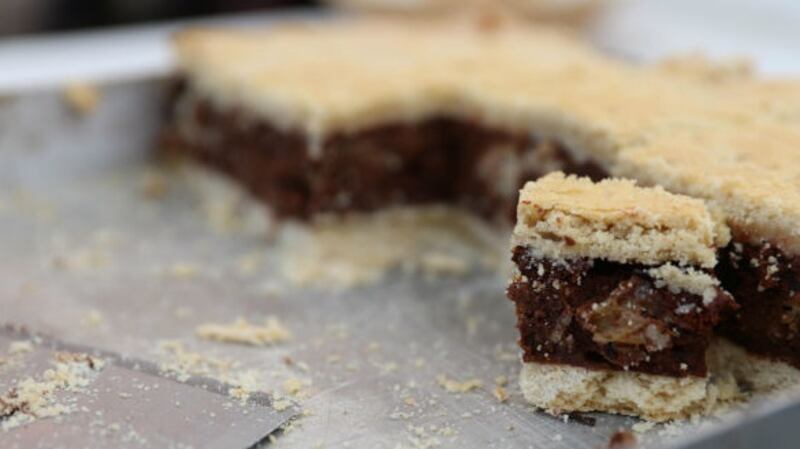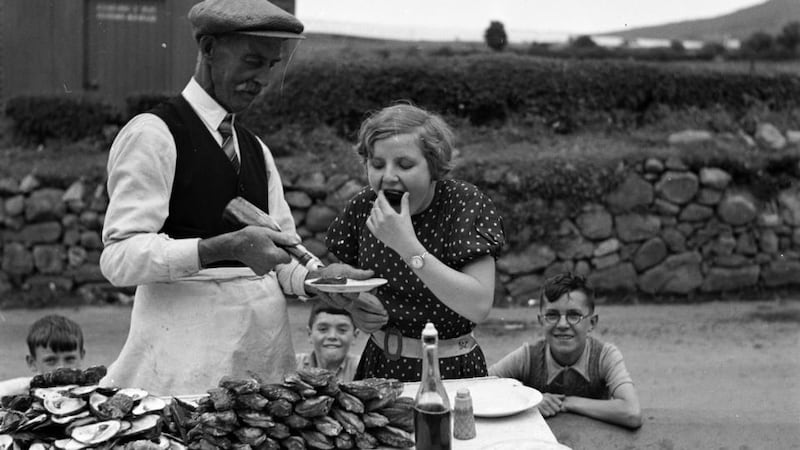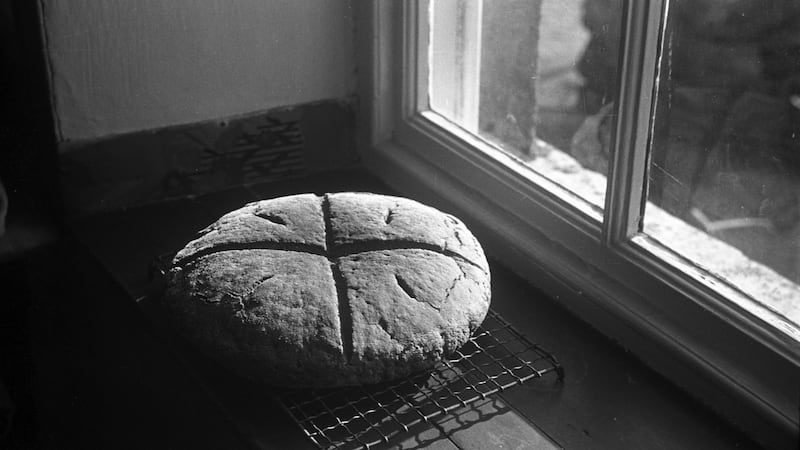What is Irish food and drink? Is it your dad's recipe for Irish stew – or does your aunt hold the only real recipe? Is it the Limerick staple of crubeens, a deep-fried pig's trotter? Dublin coddle, anyone? Or is it a simple nettle soup with brown bread?
It is these, and more: Irish food is also spiceburgers and spicebags, it's Tayto crisps and red lemonade or the peculiar Donegal drink known as McDaid's Football Special, as well as more high-end products like Donal Creedon's traditionally made Macroom Oatmeal.
Chef Darina Allen recently released Simply Delicious: The Classic Collection, a compendium of 100 recipes from her Simply Delicious books, and she's now lending her support to a new project which aims to preserve Ireland's food heritage.
Blasta is a new all-island archive of recipes and food traditions which is being collated by the National Folklore Collection in UCD, and its recipes and stories form the basis of a new series, Blasta, which began on TG4 on Halloween night. Blasta is asking members of the public to submit their old cookbooks, utensils, stories and information about food traditions.

"I was a child at the end of a certain era for Irish food," says Allen. "We used to visit my great aunt Lil in Tipperary and she was still cooking over an open fire. This was a time before people had ovens. I learned how to make apple tarts and bread in a bastible. She taught us to make butter and how to kill a pig. I'm the eldest of nine children and we used to go home from school for lunch, although we called it dinner then.
“Our mother would have a stew or colcannon for us, and we always had dessert – perhaps stewed apple or rhubarb, steamed pudding or gooseberry tart. We picked damsons, sloes, hazelnuts and blackberries in season. We gathered watercress and chopped it up to serve in a sandwich with butter; this is a nutritious green and people knew it.”
Preserving traditions
Jonny Dillon, archivist at the National Folklore Collection, says it is vital that we preserve these food traditions. "We're looking at handwritten recipes passed from parent to child or neighbour to neighbour, as well as proverbs, rhymes and stories about food, and information on household implements and items. We see the ingenuity of our ancestors in how they used every bit of an animal and their intimate knowledge of plants. We see how people on the Blasket Islands collected seabirds and their eggs to survive, and the challenges they faced were so different to the Golden Vale in Munster. We're collecting historic traditions, yes, but this is also about contemporary practices. We've collected information on how food plays a central role in calendar customs including Halloween, Christmas and Lent."

Our food culture shows how we preserve and break with the past. “The Christmas meal and its key components have traditional elements in the ham and turkey, but the dinner varies from home to home and year to year,” says Dillon. “Until recently, the food we ate changed depending on the seasons. But báirín breac, berries and apples are common at this time of year. Halloween was traditionally a day of abstinence from meat so colcannon was popular. There was a sense that the boundaries between this and the other world were thinner at this time, breac wasn’t just a cake but an item that could be used to divine the future, so we put rings and coins in it. These are playful practices but they carry huge symbolic meaning.”
Cultural influences
New traditions emerge all the time, and they're often influenced by other cultures. Today, the spice bag is a popular Asian-inspired dish that started in a Chinese takeaway in Templeogue, and it's taking its place in the pantheon of Irish food alongside stew and porter cake. It's a hangover-friendly mix of chips, crispy chicken or chicken balls, red and green peppers, chilli, onions and spices. "We put our own spin on food," says Máirtín Mac Con Iomaire, lecturer at the School of Culinary Arts in DIT. "It's why Supermac's offers an Irish version of fast food, with cheesy coleslaw chips and bacon and cheese burgers among its menu items."
Allen recalls how, in the 1970s, she and her mother-in-law, the recently deceased food icon Myrtle Allen, became concerned that many of these traditional recipes and memories were being lost. "This was largely before measurements, because people didn't have scales, so I went around the country and gathered recipes and stories. I spoke to people about thrashing the hay and having tea and spotted dog in the fields. There was a real inferiority complex at the time, with people feeling that food in the UK or US must be more sophisticated, but this isn't true: Irish food has long been wholesome and nourishing.
“Michelin-starred food can’t be reproduced at home. It’s lovely when we have the confidence to serve our traditional Irish food alongside more modern Irish cooking.”
'Blasta' airs on TG4 on Wednesday at 8.30pm. See Blasta.ie for more details.
Some Irish food traditions
Blaa: Fiercely loved by Waterford, this is a white bread bun, served in crispy or doughy varieties. Barron's bakery in Waterford continues to bake them. "It's the oven that gives the bread its uniqueness," says Mac Con Iomaire.
Boxty: "Padraig Gallagher of Gallagher's Boxty House called this potato pancake 'the caviar of Longford' and you will find it more along the northwest counties. You'll find it in Kerry too, but they call it 'stampy'."
Bread: "Bread and butter is the most basic representation of Irish hospitality," says Jonny Dillon. "Fresh, cooked daily in Irish homes, we didn't just get recipes but also gathered information on the processes involved in cooking it, from the rolling pins to the aprons used, and the memories those items invoke."

Carrageen moss: This is one of Darina Allen's favourite Irish ingredients and one she says is criminally underused. "The big challenge is to weigh it properly, as it's very light." She uses it to make a carrageen moss pudding.
Cookbooks: Hand-written recipes on scraps of paper, cuttings from newspapers and old cookbooks were the most emotionally resonant items received by the Blasta project, says Dillon. "Granny's handwritten banana bread recipe on a scrap of yellowing paper, lifted from a tin box for us, carries so much emotion and memory."
Corned beef: Not, as commonly believed, invented by Irish-Americans who couldn't get their hands on bacon to serve with their cabbage (the cabbage cooked in the bacon water, of course). There's evidence this was eaten as far back as the 12th century, says Mac Con Iomaire. "After the Cattle Acts of 1666, live cattle could no longer be exported to Britain, but corned beef could. When the Irish emigrated to New York, they encountered a lot of Jewish butchers who also had corned beef as part of their cuisine, and it quickly grew to be the national Irish dish of America."
Drisheen: A Cork dish that Mac Con Iomaire says he's not in a hurry to try again. It's a type of blood sausage with a gelatinous consistency, and it's traditionally served with tripe.
HB ice-creams: The popular ice-creams of people's childhoods have changed. People periodically call for Wibbly Wobbly Wonders and Fat Frogs to be brought back. For Dillon, the power of these brands is the memories of childhood they invoke. "They're as Irish as the great battle between King and Tayto crisps."
Maide briste: An old cooking utensil, composed of two prongs, used to cook herring on an open turf fire. "There are all sorts of superstitions associated with this utensil, including the idea that if someone is going on a long journey, you'd throw it out the door after them for good luck," says Mac Con Iomaire. "Atty Ní Ghallachóir showed us how to make the herring in Donegal, but she now uses a basket she got in Ikea which sits perfectly over her turf fire."
McDaid's Football Special: A popular soft drink synonymous with Donegal, this was invented after the successes of Swilly Rovers football club in order to fill the winning cup with a non-alcoholic drink.
Onion sauce: An old recipe passed through by this journalist's family, sneered at by lesser minds. It's little more than boiled onions in a white sauce, served with fish and potatoes.
Ronnach buí : "Filming in Connemara, we came across a tradition known as ronnach buí," says Mac Con Iomaire. "The salted mackerel is soaked in water for a few days to reconstitute it, with a few changes of water. Then the potatoes are cooked in the pot with the skin on, and three-quarters of the way through, the mackerel is added with the lid on, and the flavours get exchanged. Serve with butter and potatoes."
Stew: Possibly the most divisive Irish dish. For some, an Irish stew should be white and contain lamb, whereas others consider it as a brown beef stew. "Some add oxtail soup or Bisto to the beef stew, and others make the colour naturally," says Mac Con Iomaire. "There is no right way: the traditional method is whatever you were familiar with at home and the only good one is probably your mother's version."
Familiar Irish recipes
Porter Cake
"I have an old vanity case with pamphlets and clippings and recipes from my nana's kitchen," says Caroline Hennessy, founder and editor of Bibliocook. com. "On the morning of the shoot, this handwritten page fell out of the stack. I've recently discovered that it was written by my great aunt, Marjorie Harrington, for her sister-in-law and my grandmother, Mary Ellen Drake. I went back to the original page, which was falling apart, and managed to make out the text, although it is a little fuzzy at the end, and a little short on detail. These ladies were experienced cooks and didn't need too much extraneous information."
Ingredients
1lb flour
¾lb sugar
½lb margarine
3 eggs
¾ small bottle stout
½lb currants
½lb raisins
½tsp mixed spice
1tsp bread soda
Grated lemon rind
Method
Rub marg into flour. Add spice, sugar, cleaned fruit and lemon rind. Heat porter, pour over bread soda. Add eggs and porter to mixture. Beat for 15 minutes. Bake 2-3 hours in moderate oven.
Carrageen Moss Pudding
My favourite way to eat carrageen moss pudding is just with softly whipped cream and some soft brown sugar sprinkled over the top, but it’s also lovely with a fruit compote. The fruit used would vary with the season, but I’m giving this particular recipe because we use a wonderful variety of rhubarb that’s been passed down through the Allen family from generation to generation; even when they moved house, they brought their rhubarb and globe artichokes with them. If there’s a particularly good variety of fruit or vegetable in your family, treasure it and make sure you pass it on.
Ingredients
Serves 6
7g cleaned, well-dried carrageen moss (1 semi-closed fistful)
900ml (1½ pints) whole milk
1 vanilla pod or ½tsp pure vanilla extract
1 organic egg
1tbsp caster sugar
To Serve
Soft brown sugar and softly whipped cream or a compote of fruit in season.
Method
Soak the carrageen in a little bowl of tepid water for 10 minutes. It will swell and increase in size. Strain off the water and put the carrageen into a saucepan with the milk and the vanilla pod, if using. Bring to the boil and simmer very gently, covered, for 20 minutes.
At that point and not before, separate the egg, put the yolk into a bowl, add the sugar and vanilla extract, if using, and whisk together for a few seconds, then pour the milk and carrageen moss through a strainer onto the egg yolk mixture, whisking all the time.
By now the carrageen remaining in the strainer will be swollen and exuding jelly. You need as much of this as possible through the strainer and whisk it into the egg and milk mixture. Test for a set in a saucer as one would with gelatine.
Whisk the egg white stiffly and fold or fluff it in gently; it will rise to make a fluffy top. Serve chilled with soft brown sugar and cream, or with a compote of fruit in season.









